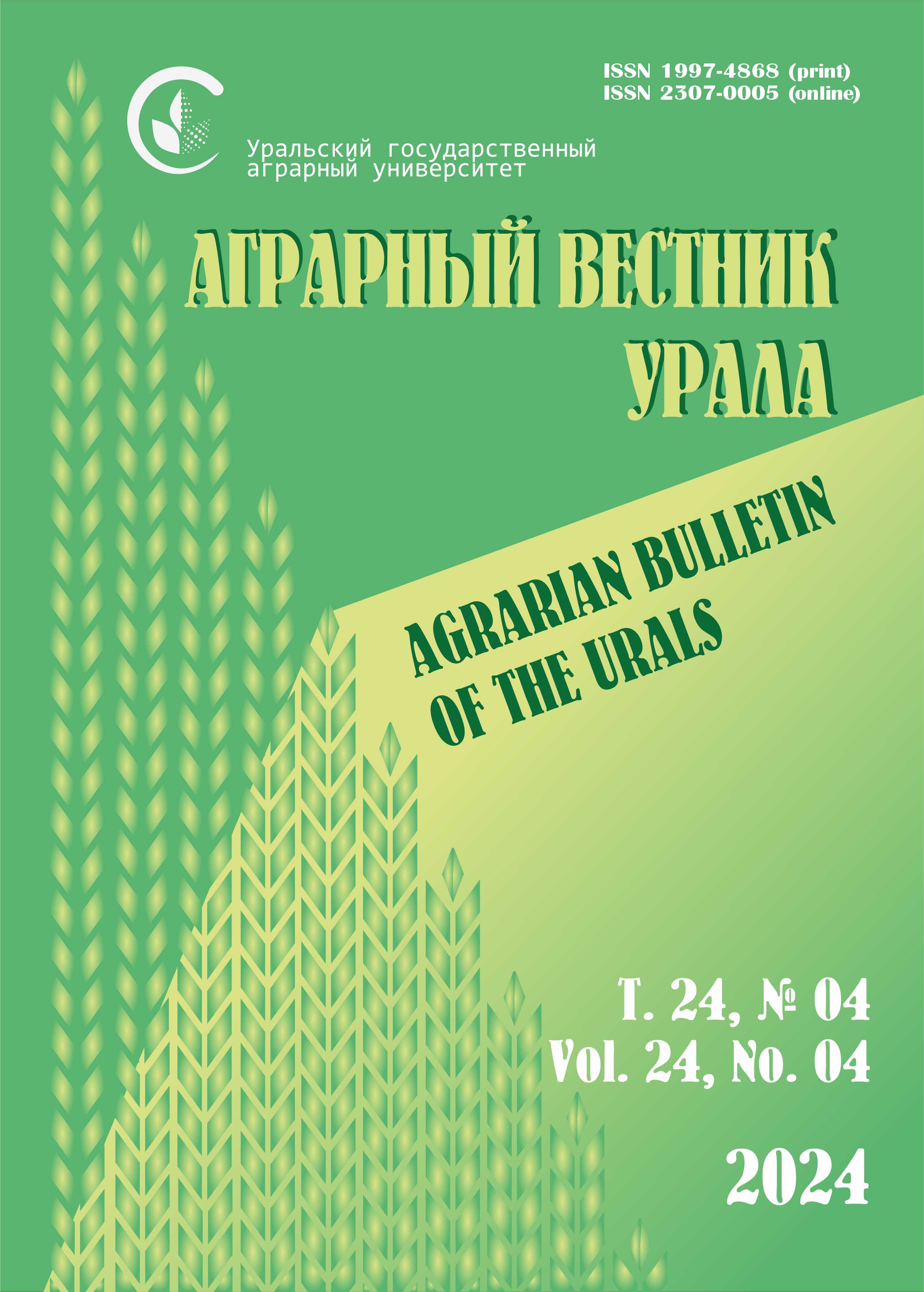Russian Federation
Relevance. The great potential for the development of the agricultural industry in the Russian Federation necessitates the study of factors influencing it. In the current crisis conditions of economic development, this direction will help identify the causes of the development of agricultural crises, make timely management decisions related to minimizing the consequences of their negative impact and rapid economic recovery. The purpose of the study is to analyze the factors of agricultural activity that can reflect the impact of instability and economic crises on the development of the agricultural sector. Methods. The methods of normalized sliding standard deviation, a model of multiple linear regression, a forecasting method based on the ARIMA model, and the Granger causality test were used. Scientific novelty. For the first time in Russian practice, the volatility of agricultural indicators was assessed, the links between these indicators and shocks in financial markets were revealed. Results. A statistical relationship between the volume of agricultural production and instability factors has been modeled, showing that 87.5 % of the variation in agricultural production can be explained by variations in variables – water, labor. The causality test showed that instability in the agricultural sector is the reason for the volatility of the RTS index, the index of industrial production. The growth of agricultural production is predicted for all three forecasting scenarios. The most likely (optimal) scenario showed an increase in production volumes to 9806,9 billion rubles by the end of 2023, to 10 707,1 billion rubles by the end of 2024 and to 11 605,1 billion rubles by the end of 2025. It is concluded that financial shocks cause an increase in volatility in agricultural markets.
agriculture, economic crisis, crisis indicators, instability factors, volatility, forecast, causality test, statistical relationship
1. Sharma R., Shishodia A., Kamble S., Gunasekaran A., & Belhadi A. Agriculture supply chain risks and COVID-19: mitigation strategies and implications for the practitioners. International Journal of Logistics Research and Applications. 2020: 1–27. DOI:https://doi.org/10.1080/13675567.2020.1830049.
2. Nakat Z., Bou-Mitri C. COVID-19 and the food industry: Readiness assessment. Food Control. 2021; 121: 107661. DOI:https://doi.org/10.1016/j.foodcont.2020.107661. EDN: https://elibrary.ru/JIOLPM
3. Walters L., Wade T., Suttles S. Food and agricultural transportation challenges amid the COVID-19 pandemic. Choices. 2020; 35: 1–8. DOI:https://doi.org/10.22004/ag.econ.305280.
4. Hall D. Russia’s invasion of Ukraine and critical agrarian studies. The Journal of Peasant Studies. 2023; 50 (1): 26–46. DOI:https://doi.org/10.1080/03066150.2022.2130263. EDN: https://elibrary.ru/CBGNPP
5. Passarelli M., Bongiorno G., Cucino V., Cariola A. Adopting new technologies during the crisis: An empirical analysis of agricultural sector. Technological Forecasting and Social Change. 2023; 186 (A): 122106. DOI:https://doi.org/10.1016/j.techfore.2022.122106. EDN: https://elibrary.ru/QGDHTN
6. Zolghadr-Asli B., McIntyre N., Djordjevic S., Farmani R., Pagliero L. The sustainability of desalination as a remedy to the water crisis in the agriculture sector: An analysis from the climate-water-energy-food nexus perspective. Agricultural Water Management. 2023; 286: 108407. DOI:https://doi.org/10.1016/j.agwat.2023.108407. EDN: https://elibrary.ru/NESBWP
7. Roubík H., Lošťák M., Ketuama C.T., Procházka P., Soukupová J., Hakl J., Karlík P., Hejcman M. Current coronavirus crisis and past pandemics – What can happen in post-COVID-19 agriculture? Sustainable Production and Consumption. 2022; 30: 752–760. DOI:https://doi.org/10.1016/j.spc.2022.01.007. EDN: https://elibrary.ru/CDTZBB
8. Selby J. Climate change and the Syrian civil war, Part II: the Jazira’s agrarian crisis. Geoforum. 2019; 101: 260–274.
9. Caball R., Malekpour S. Decision making under crisis: Lessons from the Millennium Drought in Australia. International Journal of Disaster Risk Reduction. 2019; 34: 387–396.
10. El-Sadek A. N., El-Ghany F. I. A., Shaalan A. M. Simulating the effect of tillage practices on the yield production of wheat and barley under dryland condition. Agronomy Research. 2020; 18 (4): 2374–2390. DOI:https://doi.org/10.15159/AR.20.188. EDN: https://elibrary.ru/TOZZGR
11. Laurett R., Paço A., Mainardes E. W. Measuring sustainable development, its antecedents, barriers and consequences in agriculture: An exploratory factor analysis. Environmental Development. 2021; 37 (6): 100583. DOI:https://doi.org/10.1016/j.envdev.2020.100583. EDN: https://elibrary.ru/KAVJNE
12. Collotta M., Tomasoni G. The economic sustainability of small–scale biogas plants in the Italian context: the case of the cover slab technology. Agronomy Research. 2017; 15 (2): 376–387.
13. Laurett R., Paço A., Mainardes E.W. Antecedents and consequences of sustainable development in agriculture and the moderator role of the barriers: Proposal and test of a structural model. Journal of Rural Studies. 2021. DOI:https://doi.org/10.1016/j.jrurstud.2021.06.014. EDN: https://elibrary.ru/FKHFAH
14. Graddy-Lovelace G., Diamond A. From supply management to agricultural subsidies – and back again? The U.S. Farm Bill & agrarian (in)viability. Journal of Rural Studies. 2017; 50: 70–83. DOI:https://doi.org/10.1016/j.jrurstud.2016.12.007.
15. Kornher L., Kalkuhl M. The gains of coordination – when does regional cooperation for food security make sense? Global Food Security. 2019; 22: 37–45. DOI:https://doi.org/10.1016/j.gfs.2019.09.004.
16. Yencken E. From the common agricultural policy to the Eurozone crisis: bilateral disputes in the Australia–EU relationship. The Round Table. 2018; 107 (5): 585–600. DOI:https://doi.org/10.1080/00358533.2018.1527519.
17. Lioutas E. D., Charatsari C. Enhancing the ability of agriculture to cope with major crises or disasters: What the experience of COVID-19 teaches us. Agricultural Systems. 2021; 187: 103023. DOI: https://doi.org/10.1016/j.agsy.2020.103023; EDN: https://elibrary.ru/FDMOZJ
18. Zolghadr-Asli B., McIntyre N., Djordjevic S., Farmani R., Pagliero L. The sustainability of desalination as a remedy to the water crisis in the agriculture sector: An analysis from the climate-water-energy-food nexus perspective. Agricultural Water Management. 2023; 286: 108407. DOI:https://doi.org/10.1016/j.agwat.2023.108407. EDN: https://elibrary.ru/NESBWP
19. Zolghadr-Asli, B., Bozorg-Haddad, O., Chu, X. Hydropower in Climate Change. Encyclopedia of Water. 2019: 1–5. DOI:https://doi.org/10.1002/9781119300762.wsts0089.
20. Ayadi A., Gana M., Goutte S., Guesmi K. Equity-Commodity Contagion During Four Recent Crises: Evidence from the USA, Europe and the BRICS. International Review of Economics & Finance. 2021; 76: 376–423. DOI:https://doi.org/10.1016/j.iref.2021.06.013.
21. Gong X., Jin Y., Liu T. Analyzing pure contagion between crude oil and agricultural futures markets. Energy. 2023; 269: 126757. DOI:https://doi.org/10.1016/j.energy.2023.126757. EDN: https://elibrary.ru/JHMJUG









